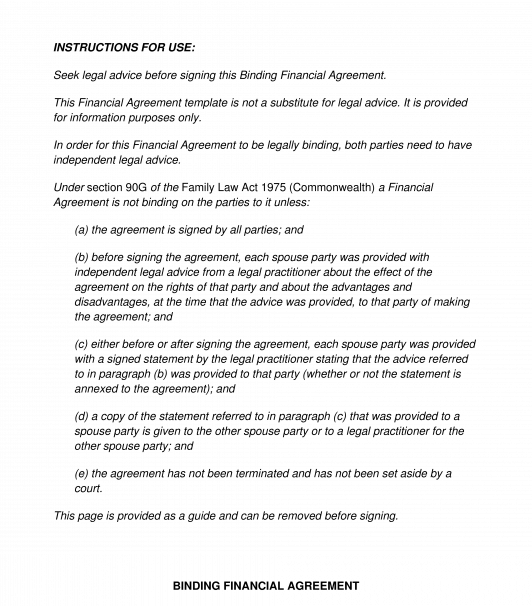 27/01/2025
27/01/2025

Answer a few questions and your document is created automatically.

Your document is ready! You will receive it in Word and PDF formats. You will be able to modify it.

 27/01/2025
27/01/2025
 Word and PDF
Word and PDF
 17 to 22 pages
17 to 22 pages



This Prenuptial Agreement, also referred to as a Binding Financial Agreement is a contract entered into between two people before they get married.
This document is designed to be used before the parties get married. It confirms their genuine commitment to each other and their desire to build a shared life together. At the same time, it acknowledges that any relationship may break down in future. The document describes how the couple will handle their family responsibilities and protect and divide their marital assets in the event that they separate.
A Prenuptial Agreement is referred to as a "Binding Financial Agreement" under Australia's Family Law Act 1975 (Commonwealth) (the "Act"). It addresses issues of child and spousal support, division of debts and assets, child custody and parenting time arrangements, and division of the marital home. It is designed to finalise these matters fairly so that the parties have certainty about their circumstances moving forward.
It is in both parties' interests that the agreement is legally binding, so they know that no further claims can be brought by the other party in future. Under section 90G of the Act a Financial Agreement is not binding on the parties to it unless:
(a) the agreement is signed by all parties; and
(b) before signing the agreement, each spouse party was provided with independent legal advice from a legal practitioner about the effect of the agreement on the rights of that party and about the advantages and disadvantages, at the time that the advice was provided, to that party of making the agreement; and
(c) either before or after signing the agreement, each spouse party was provided with a signed statement by the legal practitioner stating that the advice referred to in paragraph (b) was provided to that party (whether or not the statement is annexed to the agreement); and
(d) a copy of the statement referred to in paragraph (c) that was provided to a spouse party is given to the other spouse party or to a legal practitioner for the other spouse party; and
(e) the agreement has not been terminated and has not been set aside by a court.
How to use this document
Both parties should provide complete, honest and accurate disclosure about their financial circumstances, including all assets, liabilities, and sources of income. If a party does not provide full disclosure, then the agreement may be overruled by a court at a later date, which could allow the other party to make a subsequent claim.
The parties should think carefully about a division of assets which is fair and reasonable for both parties. If one party pressures the other to agree to an unreasonable split of assets, then the lawyers are unlikely to sign off on the agreement, which means the parties will be forced into more protracted negotiations and extra legal costs. Furthermore, the agreement can be overturned if there is evidence that one party was coerced to sign it or signed it under duress. For example, if one party presents the agreement to the other party on the evening of their wedding and says that the wedding will be called off if they do not sign it, then it is likely that the agreement could be overturned.
Ultimately, for a Binding Financial Agreement to be legally binding in Australia, the parties need to both have independent legal advice and they need each of their lawyers to sign off on the agreement. However, in many spousal separation matters, the parties can save a significant amount of money if they are able to work together to compile a complete list of their assets and liabilities, and come to some kind of reasonable agreement about how they are going to split their finances, before they each go to see their lawyer. This document is designed to help the parties to do that. Alternatively, the parties may work through this document with their lawyer to develop a final document for signing.
Once the parties have come to an "in principle" agreement, they can set it out in the document, and download it in word format. They both need to make appointments with different independent lawyers who can provide advice about the agreement they have reached, and may suggest some amendments.
For the document to be finalised, the parties both need to have an appointment with their own independent lawyer to obtain advice about the effect of the document, and their lawyers both need to sign the document to certify that they have provided the parties with independent legal advice. Each party needs to sign the document in front of two witnesses.
Applicable law
The Family Law Act 1975 (Commonwealth) governs family law and separation in Australia. Part VIIIA of the Act deals with financial agreements. Section 90B deals with financial agreements before marriage. Section 90G of the Act specifies what needs to happen for an agreement to be binding.
How to modify the template
You fill out a form. The document is created before your eyes as you respond to the questions.
At the end, you receive it in Word and PDF formats. You can modify it and reuse it.
Guides to help you
Prenuptial Agreement - sample template - Word and PDF
Country: Australia